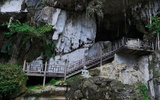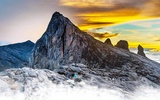Bako National Park is located on the island of Borneo, and is the oldest national park in Sarawak state, East Malaysia. It is 37 kilometres from Kuching and easily accessible on a day trip. The park covers the northern tip of the Muara Tebas Peninsula, with an area of 27 kilometres square.
Bako has an outstanding diversity of natural landscapes in a relatively small area as the park consists of coastal cliffs and rolling hills, mangrove forest, swamp forest, mixed dipterocarp forest, cliff vegetation and fine sandy beaches surrounded by jungle. However, Bako National Park is most famous for its interesting sea stacks and rock formations produced by coastal erosion over millions of years.

